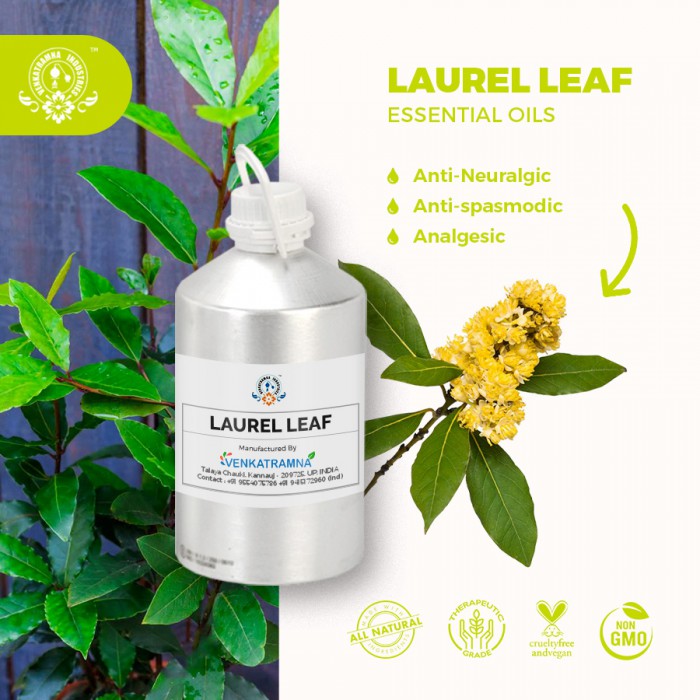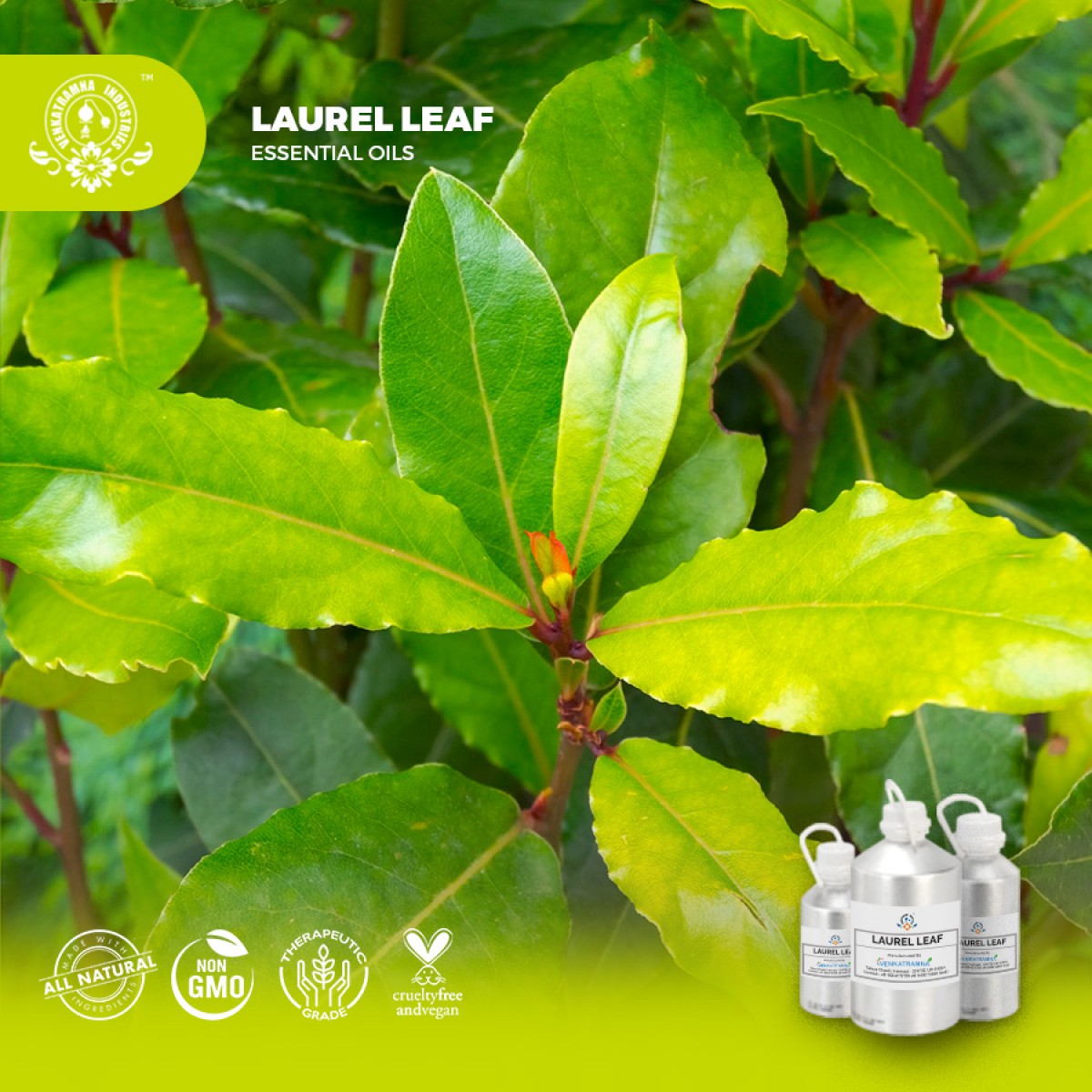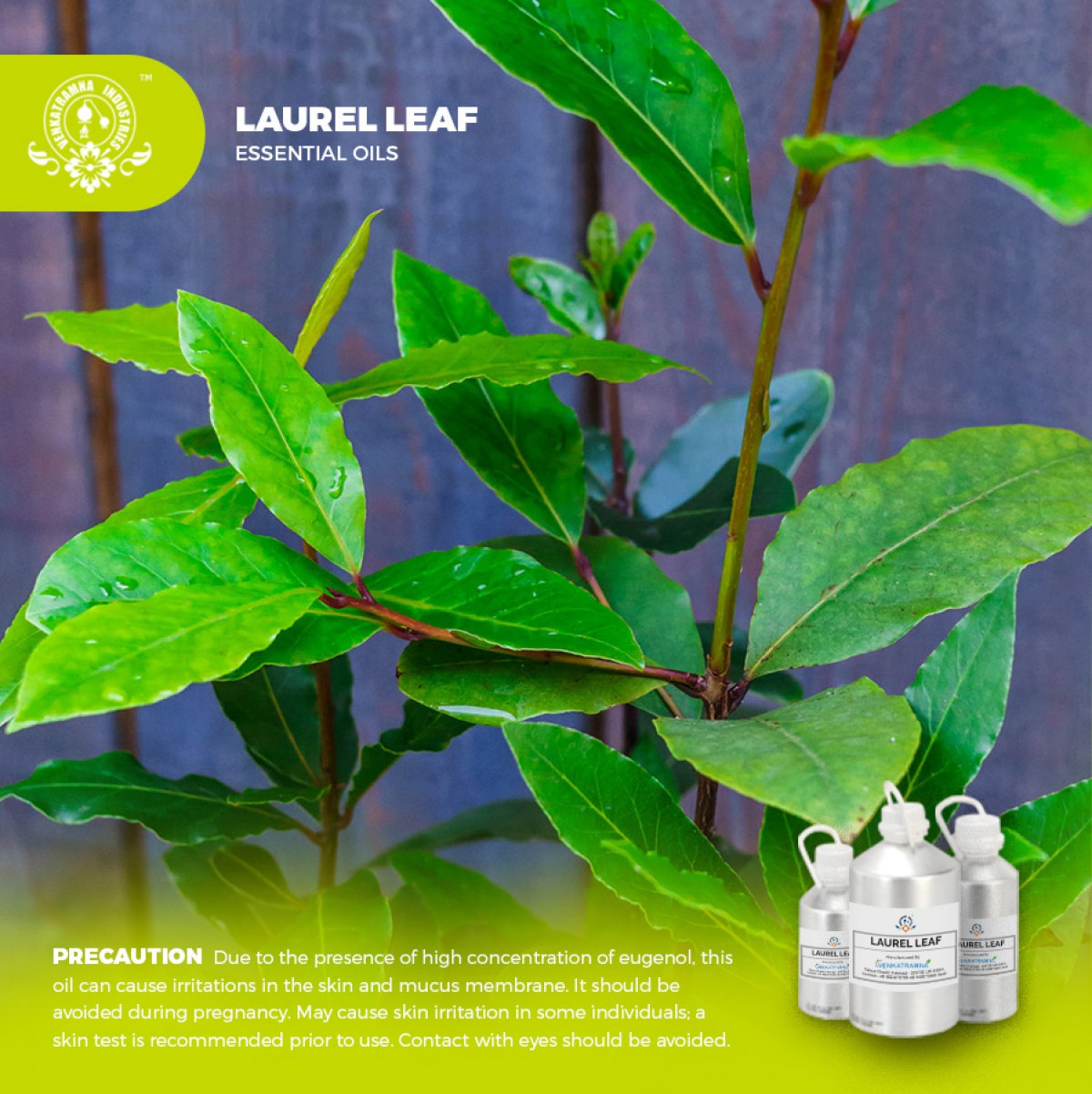Botanical Name: Laurus nobilis Common name: Bay leaf Plant family: Read More
|
Botanical Name: |
Laurus nobilis |
|
Common name: |
Bay leaf |
|
Plant
family: |
Lauraceae |
|
Genus: |
Laurus |
|
Appearance/Color: |
Pale
yellow-green liquid |
|
Odor: |
A top note with a
strong aroma, Laurel Leaf Essential Oil has a fresh, strong but sweet,
camphoraceous, and somewhat spicy odor |
|
Blends With: |
With Clary Sage,
Orange, Cypress, Hyssop and Juniper |
|
Origin: |
Slovenia |
|
Source: |
Leaves |
|
Method of Extraction: |
Steam Distillation |
The laurel tree
is a small unimpressive shrub or tree, originating in the eastern Mediterranean
countries. The evergreen tree reaches maturity after five years and yields
about 5 kg of leaves per season, which in turn gives about 50-70 g of essential
oil.
Bay laurel was
used to fashion the laurel wreath of ancient Greece, a symbol of highest
status. A wreath of bay laurels was given as the prize at the Pythian Games
because the games were in honor of Apollo, and the laurel was one of his
symbols.
The symbolism
carried over to Roman culture, which held the laurel as a symbol of victory. It
is also the source of the word’s baccalaureate and poet laureate, as well as
the expressions "assume the laurel" and "resting on one's
laurels". Ovid tells the story in the Metamorphose that laurel tree was
first formed when the nymph Daphne was changed into a laurel tree because of
Apollo's pursuit of her. Daphne is the Greek name for the tree.
The essential
oil is extracted from the bay laurel leaves by steam distillation. The oil has
herbaceous and spicy scent and comes in numerous variations.
For example, the oil produced in North Africa has an aroma reminiscent of eucalyptus due to the high content of cineol while the oil produced in Italy or France has a lower cineol content resulting in an aroma most people associate with the laurel leaves used in cooking.
DISCLAIMER
The complete range of conditions
or methods of use are beyond our control therefore we do not assume any
responsibility and expressly disclaim any liability for any use of this
product. Information contained herein is believed to be true and accurate however,
all statements or suggestions are made without warranty, expressed or implied,
regarding accuracy of the information, the hazards connected with the use of
the material or the results to be obtained from the use thereof. Compliance
with all applicable federal, state, and local laws and local regulations
remains the responsibility of the user.
The FDA has not evaluated the
statements on this website. No claims are made by Venkatramna Industries as to
the medicinal value of any products from vriaroma.com or by us. The information
presented here is for educating our customers about the traditional uses of
essential oils and is not intended to diagnose, treat, cure, or prevent any
disease. You are responsible for understanding the safe application of these products.
If you have any questions, please call or email us for further information.
As per NAHA guidelines, New Directions Aromatics
(NDA) does not recommend the ingestion of essential oils. It is imperative to
consult a medical practitioner before using Essential Oils for therapeutic
purposes. Pregnant and nursing women and those taking prescription drugs are
especially advised not to use this product without the medical advice of a
physician. The oil should always be stored in an area that is inaccessible to
children, especially those under the age of 7.
Laurel Leaf has
been known for thousands of years, but the use of its leaves as a household
culinary is believed to be comparatively recent one.
Laurel leaf
Essential oil in Pharma
Laurel
Leaf essential oil is good for cleaning. One of its main chemical constituents
is eucalyptol, which is highly cleansing. It is gentle enough to be used to
help cleanse the skin, yet powerful enough to be used as a refreshing surface
cleanser. Laurel Leaf oil is also soothing to the skin. Used topically with a
massage, it offers a soothing and relaxing experience. Laurel Leaf essential
oil also reduces the appearance of blemishes and promotes a clear looking
complexion.
Essence of Laurel leaf Essential oil
Laurel Leaf essential oil promotes a courageous and confident environment. It supports feelings of
concentration, focus, and clarity. Diffuse or simply take a few deep inhales of
Laurel Leaf essential oil when you need an invigorating, uplifting aroma.
COMMON USAGE
·
Antiseptic
·
Antibiotic
·
Antineuralgic
·
Antispasmodic
·
Analgesic
·
Cholagogue
·
Emenagogue
·
Febrifuge
·
Insecticide
·
Sedative
·
Stomachic
·
Sudorific
·
Tonic
Ingredients:
|
S.No |
Key Constituents |
Strength (%) |
|
1 |
1,8-Cineole |
38.1–43.5 |
|
2 |
a-Pinene |
7.1–15.9 |
|
3 |
a-Terpinyl acetate |
4.5–7.0 |
|
4 |
Linalool |
6.2–6.5 |
|
5 |
b-Pinene |
4.9–6.5 |
|
6 |
Sabinene |
4.5–6.5 |
|
7 |
Methyl eugenol |
1.4–3.8 |
|
8 |
Eugenol |
1.2–3.0 |
|
9 |
Camphene |
0.7–2.9 |
|
10 |
Linalyl acetate |
0.4–2.7 |
|
11 |
Bornyl acetate |
0.4–2.3 |
|
12 |
Terpinen-4-ol |
2.1–2.2 |
|
13 |
a-Terpineol |
0.9–1.9 |
|
14 |
b-Myrcene |
0.7–1.5 |
|
15 |
Borneol |
0.1–1.5 |
|
16 |
b-Caryophyllene |
0.1–1.5 |
|
17 |
Terpinolene |
0.1–1.1 |
|
18 |
g-Terpinene |
0–1.0 |
TOXICOLOGICAL INFORMATION
Safety
summary
·
Hazards: Potentially carcinogenic, based on methyl eugenol content;
essential oils high in 1,8-cineole can cause CNS and breathing problems in
young children; skin sensitization (low risk); mucous membrane irritation (low
risk).
·
Contradiction: Due to the
presence of high concentration of eugenol, this oil can cause irritations in
the skin and mucus membrane. It should be avoided during pregnancy. May cause
skin irritation in some individuals; a skin test is recommended prior to use.
Contact with eyes should be avoided.
Cautions: (dermal) Hypersensitive, diseased or damaged skin, children under
2 years of age. Some laurel leaf oils may cause skin sensitization.
Maximum adult
daily oral dose 18 mg
Maximum
dermal use level
·
EU 0.005%
·
IFRA 0.01%
Safety advice:
Recommended
dermal maximum of 0.5% and an oral maximum of 18 mg, based on 3.8% methyl
eugenol content with dermal and oral limits of 0.02% and 0.01 mg/kg.
Regulatory guidelines:
IFRA recommends
that the maximum concentration of methyl eugenol for leave-on products such as
body lotion should be 0.0004%. The equivalent SCCNFP maximum is 0.0002%.
Organ-specific
effects
·
Adverse skin reactions: In a 48-hour occlusive patch test on 50 Italian volunteers,
undiluted laurel leaf oil produced no adverse reactions. Similarly tested at
1%, it produced no reactions in 380 eczema patients (Meneghini et al 1971).
Undiluted laurel leaf oil was moderately irritating to rabbits, but was not
irritating to mice or pigs. Tested at 2% on 25 volunteers it was not
irritating, nor was it irritating when re-tested at 10%. A second sample of
laurel leaf oil was not irritating when tested at 10% on two separate panels of
volunteers. Laurel leaf oil was non-phototoxic in hairless mice and swine.
Systemic
effects
·
Acute toxicity: Laurel leaf oil acute oral LD50 in rats 3.95 g/kg;
acute dermal LD50 in rabbits >5 g/kg. 1,8- Cineole has been reported to
cause serious poisoning in young children when accidentally instilled into the
nose.
·
Antioxidant/pro-oxidant
activity: A laurel leaf oil showed moderate
antioxidant activity in scavenging DPPH radicals and inhibiting lipid
peroxidation.
·
Carcinogenic/anticarcinogenic
potential: Laurel leaf oil containing 2.5% methyl
eugenol was active against human melanoma, renal cell adenocarcinoma, and human
chronic myelogenous leukemia cell lines in vitro. Methyl eugenol is a rodent
carcinogen if exposure is sufficiently high.
ECOLOGICAL
INFORMATION
·
Acute fish toxicity:
LC50 / 96 HOUR – No data available
·
Toxicity to aquatic plants – No
data available
·
Toxicity to microorganisms – No
data available
·
Toxicity threshold – No data
available
·
Bioaccumulation: No data
available
·
Mobility in soil: No data
available
·
Persistence and degradability:
No data available
·
PBT and vPvB assessment: No
data available





 MSDS-Lurel.pdf
MSDS-Lurel.pdf




